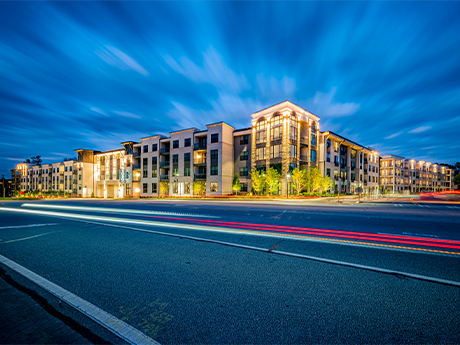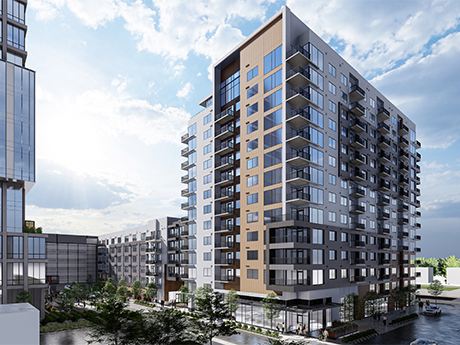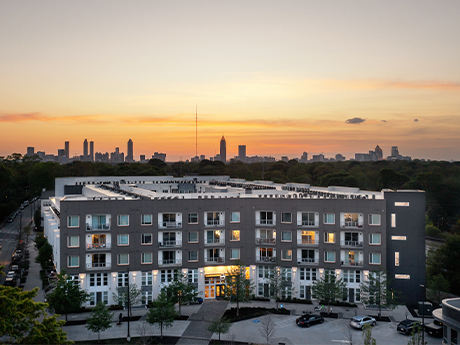Atlanta has experienced a dip in rents amid a surge of supply. The number of deliveries in the third quarter of this year increased 63 percent compared with the same period in 2022.
Most data sources indicate about 15,000 units have been delivered so far this year, but only about 5,000 have been absorbed. In short, new supply is greatly outpacing tenant demand, and effective rents fell on a year-over-year basis as of the third quarter.
Still, industry experts say this is likely only a temporary condition with developers struggling to secure financing for new projects. New construction starts are expected to decrease dramatically through 2025, while various tailwinds will propel renter demand, say most market experts.
For-sale home prices are one of those driving forces. When faced with the choice between buying or renting, most Atlantans will likely choose to rent. The Urban Land Institute (ULI) reports that housing costs are rising faster than median incomes.
The organization reported in a 2023 Atlanta housing study that the median annual income in the five metro counties — Fulton, Dekalb, Cobb, Gwinnett and Clayton — is $81,278. Depending on the source, Atlanta home prices average between $400,000 and $450,000. Redfin data from November of this year reports an Atlanta buyer would need an annual income of $107,731 to afford to buy a median-priced house.
Nationally, Redfin’s data indicates a homebuyer must earn $114,627 to afford the average-priced American home, which is up 15 percent from a year ago and up more than 50 percent since the start of the pandemic. The real estate company says that’s the highest annual income necessary to afford a home on record.
Pipeline Peters Out
Atlanta is grinding through typical aches and pains plaguing most Sun Belt markets today, like oversupply and slowing rent growth. RealPage reports that 36,575 units are under construction in Atlanta, and about 22,000 of those units will be completed within the next year.
Deliveries have been on the upswing in the past two years. Cushman & Wakefield reports 14,893 units have been delivered year-to-date through September, compared with 9,333 units delivered during the same period in 2022.
While these supply figures may be concerning given that the average effective rent decreased 3.6 percent in the third quarter on a year-over-year basis, per Cushman, experts say the market soon will adjust in favor of landlords.
“Many projects currently under construction were capitalized in 2021 or 2022 before the Fed rates increased and the regional banking crisis this past spring,” says Scott Bray, managing director with Berkadia Atlanta.
“The ability to capitalize any future developments in this higher interest rate environment has been extremely challenging for developers. Construction costs are higher, and availability of construction debt and equity is very limited and expensive,” emphasizes Bray.
These challenges mean that new deliveries will begin to taper off in 2024 and beyond. “This will be very positive for the general health of the multifamily market moving forward.”

Style Sets Submarkets Apart
Most submarkets have vastly differing supply-demand and asset-performance metrics as well as unique renter demographic traits. Inside the perimeter of I-285, the growing Atlanta Beltline trail dotted with mixed-use projects, some of which are historical redevelopments, are attracting Gen Z and millennial renters.
In the northern suburbs, high-rated school districts and a growing number of commercial town center projects are attractive to an older demographic. To the south, experts say investment opportunities abound for future development. Major real estate in that area includes Tyler Perry Studios and the $111 million East Point Commons.
“While I would consider Atlanta overbuilt in some areas now, that moment will be extremely short-lived due to the number of projects that have been cancelled or have been unable to be capitalized or sold in 2023 and 2024,” says Brooks Colquitt, managing director with Cushman & Wakefield’s Sunbelt Multifamily Advisory Group. “This lack of new development will create a lack of supply in 2026 and 2027.”
A pervasive NIMBY (not in my backyard) attitude also has effectively reined in development. “Across the MSA, it is more and more difficult to deliver new product as many cities and areas continue to have an underlying aversion to multifamily,” says Rob Sucher, managing director of development at Atlanta-based RangeWater Real Estate.
Several municipalities aim to slow the construction of new apartments, and one community has even put a temporary moratorium on the issuance of multifamily housing permits.
The share of renter households in Alpharetta, a northern suburb of Atlanta, is currently 32.3 percent, down from 37.4 percent in 2015. City officials want to maintain the current ratio, which means new development is unlikely.
In April of this year, the Marietta City Council put a halt on multifamily permits for six months. And in 2022, the City of Roswell banned the construction of standalone apartment complexes. Today, apartments in Roswell can only be built if paired with other uses.
BTR Model Gains Public Backing
Many homeowners and zoning boards typically state that their objections to new apartment construction stem from a fear of higher traffic volume and strains on infrastructure. But the increasingly popular, lower density build-to-rent (BTR) product type skirts some of those potential future problems.
Atlanta ranked third for the highest number of BTR units under construction, behind Phoenix and Dallas, according to RealPage. The real estate research firm reports that 4,372 units are currently under construction, while another 851 units are in the planning phase.
CBRE defines BTR as investor-owned rental communities consisting of 50 or more single-family homes or townhomes. No one lives above or below a BTR resident, says CBRE. Amenities can vary property by property, but BTR owners typically offer management services, including an onsite leasing office, in a manner comparable to conventional apartment complexes.
According to the Urban Institute Housing Policy Finance Center, some BTR developers invest in amenity-rich developments with features like pools, gate access and fitness centers in order to command rents high enough to offset both the initial costs and the operating costs. Other developers believe the house itself is the amenity.
Townhomes are now considered to constitute the “lower end of the spectrum,” while single-family, detached homes are often more luxurious and can pull in higher-income renters, according to research published by the institute in June of this year.
CBRE reports that millennials and empty nesters are driving tenant demand. Millennials are reaching or are within prime age for major life milestones such as owning a home or starting a family. However, many are paying off large college loans and cannot yet afford homeownership. Empty nesters are attracted to the product type because of financial flexibility and ease of lifestyle.
“There is no denying that build-to-rent development is in vogue right now, and that certainly rings true for the Atlanta MSA,” says Matt White, managing director with Berkadia Atlanta. White explains that, given the larger footprint required for BTR projects, investors and developers are likely to find up-and-coming opportunities in the metro’s southern suburban sites.
“Although very few submarkets within Atlanta fly under the radar, I would encourage investors to pay particular attention to southside bedroom communities such as Newnan, Peachtree City, McDonough and Fayetteville,” White continues.
“You can often find value in these locations, given that out-of-state investors are routinely told to stay north of I-20 when making their foray into Atlanta. The demographics and underlying fundamentals of these submarkets mirror high-demand areas across the northern arc of Atlanta.”
According to the Atlanta Regional Commission (ARC), the population of Fayette County, home to Peachtree City and Fayetteville, grew 1.3 percent between April 2022 and April 2023, and Henry County, where McDonough is located, grew 2.1 percent during the same period.
Colquitt concurs that hidden-gem submarkets come bearing opportunities. He also says replacement costs should be a top consideration for Atlanta investors. “In a perfect world, if I had a bucket of capital that was product-agnostic, I would focus on new builds throughout the metro at a basis that is well below today’s replacement cost,” he says.
“I would also focus on the less desirable submarkets, as sellers there are feeling massive pressure from the equity, debt and financial performance of their assets, creating lower-price deals and the ability to scale up quickly while the competition is light.”
Colquitt explains that the Atlanta multifamily market can be divided into three zones, each with its own set of unique characteristics. The first is the city of Atlanta, which includes Midtown, Buckhead, West Midtown the Beltline and Old 4th Ward area.
Properties in this zone attract young renters who value walkability. Colquitt says 90 percent of office space in these neighborhoods is leased to big businesses. Operators in this zone charge higher rents and report low delinquency.
Rent Cafe reports that, as of November, Midtown renters paid an average, inclusive of all floor plans, of $2,228 per month. At $2,306, Buckhead Heights tenants paid the highest monthly rent in the metro. Comparatively, East Atlanta rents were $1,717. In Avalon in Alpharetta, tenants pay about $1,608 monthly.
Secondly, the North Atlanta and far West, South and East submarkets tend to consist of older assets in less walkable neighborhoods. However, a good number of town center developments and high-rated school districts attract tenants willing to pay medium to high rents.
Lastly, Colquitt explains that South Atlanta is home to limited new development but still has healthy demand for apartments.

Projects Deliver Bonus Features
The town center or large mixed-use developments throughout the metro, as Colquitt noted, can be magnets for renter demand and developer interest.
Assembly Yards, a 130-acre, 10-millionsquare-foot redevelopment of a former General Motors plant, for example, provided an impetus for RangeWater Real Estate to build Camino in Doraville. Walkable to Assembly Yards, Camino is a 304-unit project that RangeWater broke ground on in September, with completion slated for spring 2025. This is the 26th Atlanta development for RangeWater and the fourth project utilizing the company’s new in-house construction division.
In addition to the apartments, RangeWater is building out a new section of the Peachtree Creek Greenway trail that will serve as the “front-door” for the apartment community along Stewart Road. This segment is part of the City of Doraville’s and the PATH Foundation’s goal to expand the area’s network of trails, which will offer future connectivity to city hall as well as the Doraville MARTA station.
In addition to the allure of Assembly Yards, RangeWater was drawn to demographic and population trends surrounding Buford Highway, an area that covers Fulton, Dekalb and Gwinnett counties and is known for its international restaurants and retail.
“Atlanta continues to benefit from in-migration and a diversity of talent and employment,” says Sucher. “Camino was a result of our belief in Buford Highway, a truly unique, vibrant and diverse corridor that encapsulates Doraville’s rich multicultural fabric. Buford Highway has become a hub where various communities converge to celebrate their respective cuisines, languages and traditions. One of the only missing pieces is a high-quality rental option, which we hope to fill with our active investment.”
Like the metro’s large number of new mixed-use projects, universities are also attracting multifamily development. High Street Residential (HSR), the residential subsidiary of Trammell Crow Co. (TCC), topped out construction in August of The Grace near Georgia Tech. Preleasing for The Grace will begin in early 2024, with the first resident move-ins slated for late March. The target date for the building’s completion is May 2024.
The Grace is comprised of a 14-story tower and a connected six-story mid-rise building with 280 units. The developer received a tax abatement from the Fulton County Development Authority and will designate 28 units at the property as affordable and reserved for renters earning at or below 80 percent of the AMI.
In addition to The Grace, HSR and TCC partnered with Georgia Advanced Technology Ventures, an affiliate of Georgia Tech, on Science Square. This first phase includes The Grace as well as Science Square Labs, a 364,740-squarefoot lab and office tower. The tower offers up to 35,558 square feet per floor designed for lab buildouts. Portal Innovations, a life sciences venture capital firm, signed on as the building’s first tenant in August, leasing approximately 33,000 square feet.
Developers and investors like the West Midtown area because it is young and growing. The area has attracted several tech companies in recent years, including Adobe, Sovos Software and Outreach. According to a report from Cushman & Wakefield, nearly 80 percent of residents in this neighborhood, known as a “micro market,” are millennials or Gen Z-ers.
“The urban core of Atlanta has continued to grow, with strong employer and population growth fueling a very active urban environment,” explains Scott Kirchhoff, senior vice president with HSR in Atlanta.
“In particular, Midtown and West Midtown have seen robust population growth and are projected to have strong growth over the next five years. These neighborhoods have seen a boom of employers, restaurants and housing. Layered with the university presence, this is creating a very exciting live-work-play environment that we expect will continue to drive more housing demand for years to come.”
As part of the Science Square mixed used development, TCC/HSR is also investing $500,000 to fund a training institute program to introduce students, teachers and adults of the adjacent neighborhoods to careers in life sciences.
According to ARC, the City of Atlanta added 14,300 residents between August 2022 and August 2023, which was about triple the figure from the previous 12-month period. The City of Atlanta’s total population is 521,315.
ARC forecasts that the number of jobs in the Atlanta metro will increase by 1.2 million by 2050. ARC also reports that Cobb, DeKalb, Fulton and Gwinnett counties will experience most of this job growth.
“We continue to be believers in Atlanta,” says Sucher. “We are proud to call it home and believe its best days are ahead. Consistent population growth, a diverse economy spanning various industries, a resilient job market, ongoing infrastructure development and a wealth of cultural attractions all contribute to its claim as the Capital of the South.”
— By Lynn Peisner. This article originally appeared in the Nov/Dec issue of Southeast Multifamily & Affordable Housing Business.


